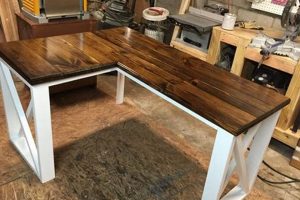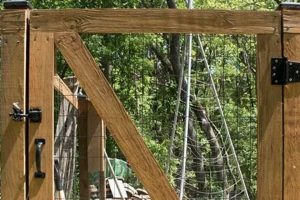The creation of decorative items from natural materials, specifically using conifer cones arranged in a circular fashion, is a popular craft activity. This project allows individuals to customize home decor using readily available resources, often sourced directly from nature. An example includes affixing the aforementioned cones to a base, such as a wire form, to produce an ornamental piece intended for display on doors or walls.
Such undertakings provide numerous advantages, ranging from cost-effectiveness and creative expression to fostering an appreciation for natural beauty. Historically, the incorporation of natural elements into home decorations reflects a connection to the environment and seasonal cycles, a practice that continues to resonate with many. Furthermore, engaging in crafting activities can be a relaxing and rewarding experience.
This discussion now transitions to exploring the specific materials and techniques required for successfully completing this type of project. Details regarding cone preparation, wreath base selection, adhesive options, and embellishment possibilities will be addressed in subsequent sections.
Essential Guidance for Creating a Pinecone Adornment
The successful assembly of a durable and aesthetically pleasing pinecone creation relies on adherence to fundamental principles and meticulous execution. The following guidelines are presented to assist in achieving optimal results.
Tip 1: Cone Preparation: Thoroughly clean harvested cones. Remove debris such as needles, dirt, and any insects. Baking cones at a low temperature (approximately 200F) for a short period can further sanitize them and encourage complete opening.
Tip 2: Base Selection: Choose a sturdy foundation appropriate for the intended size and weight. Options include wire forms, foam rings, or grapevine bases. Ensure the base is structurally sound and capable of supporting the attached cones.
Tip 3: Adhesive Application: Employ a high-strength adhesive formulated for bonding porous materials. Hot glue, while offering quick adhesion, may not provide long-term durability. Consider using a construction adhesive for enhanced permanence.
Tip 4: Cone Arrangement: Plan the cone layout prior to permanent attachment. Experiment with different patterns and orientations to achieve the desired visual effect. Symmetry or asymmetry can be employed depending on aesthetic preferences.
Tip 5: Securing Cones: Apply adhesive liberally to the base of each cone and firmly press it against the foundation. Hold the cone in place for a brief period to allow the adhesive to set partially before releasing.
Tip 6: Embellishment Considerations: Incorporate additional decorative elements judiciously. Ribbons, berries, or artificial foliage can enhance visual appeal, but excessive ornamentation may detract from the natural beauty of the cones.
Tip 7: Hanging Mechanism: Securely attach a hanging mechanism to the back of the finished piece. Wire loops or sturdy ribbon are suitable options. Ensure the attachment point is capable of supporting the total weight of the constructed item.
Adherence to these recommendations will contribute to the production of a visually appealing and enduring pinecone creation suitable for seasonal or year-round display.
The subsequent section will address troubleshooting common challenges encountered during the crafting process and offer solutions for resolving potential issues.
1. Cone preparation
Cone preparation represents a foundational step in the creation of durable and aesthetically pleasing pinecone wreaths. The quality of preparation directly influences the longevity and visual appeal of the finished decorative item. Neglecting this phase can lead to premature degradation and aesthetic deficiencies.
- Debris Removal
The initial phase of cone preparation involves the meticulous removal of debris, including needles, dirt, and organic matter. Residual debris can attract pests, foster mold growth, and compromise the adhesive bond between the cone and the wreath base. Manual brushing and rinsing are recommended techniques for effective debris removal.
- Pest Elimination
Cones sourced from natural environments may harbor insects or their larvae. Heat treatment, typically achieved through baking at low temperatures, serves to eliminate these organisms. This process prevents infestations that can compromise the structural integrity of the completed wreath over time. Proper ventilation during baking is essential to prevent moisture buildup.
- Moisture Reduction
Excess moisture within pinecones can contribute to dimensional instability and promote the growth of mold or mildew. Drying cones, either through air drying or low-temperature baking, reduces the moisture content and minimizes the risk of these issues. Cones should be thoroughly dried before adhesive is applied to ensure a strong and lasting bond.
- Shape Stabilization
Pinecones naturally open and close in response to humidity levels. Heat treatment can stabilize the cone’s shape, minimizing future movement and preventing disruption of the wreath’s design. Baking at a low temperature encourages the scales to fully open, creating a more uniform and aesthetically pleasing appearance.
The outlined facets of cone preparation are critical determinants of the overall quality and durability of pinecone wreaths. Thorough attention to these details ensures that the finished product remains visually appealing and structurally sound for extended periods. The investment of time and effort in proper cone preparation represents a crucial element in achieving a successful and lasting decorative outcome.
2. Base durability
Base durability represents a critical determinant of the longevity and structural integrity of any handcrafted pinecone wreath. The foundation upon which the cones are affixed directly influences the wreath’s ability to withstand environmental stresses and maintain its intended form over time. Selection of an appropriate base material is thus paramount to the successful creation of a lasting decorative piece.
- Material Composition
The material composing the wreath base dictates its resistance to physical damage and environmental degradation. Wire forms offer inherent strength and flexibility, while foam rings provide lightweight support but are susceptible to crushing. Grapevine bases present a rustic aesthetic but may be prone to decay if not properly treated. Selection should be based on the intended environment and anticipated handling of the finished wreath.
- Structural Integrity
The base must possess sufficient structural integrity to support the weight of the pinecones and any additional embel
lishments. A flimsy or inadequately constructed base will likely deform or break under load, compromising the wreath’s appearance and stability. Reinforcement techniques, such as wiring or gluing multiple layers together, can enhance the base’s load-bearing capacity. - Environmental Resistance
Outdoor display exposes the wreath base to a range of environmental factors, including moisture, sunlight, and temperature fluctuations. These elements can accelerate the degradation of susceptible materials. Weather-resistant coatings, such as sealants or paints, can mitigate these effects and prolong the lifespan of the base. Material selection should prioritize resistance to rot, corrosion, and UV damage.
- Size and Form Compatibility
The dimensions and shape of the base must be compatible with the intended size and aesthetic of the finished wreath. An undersized base will result in a crowded and unstable arrangement, while an oversized base may detract from the visual impact of the pinecones. The base’s form should complement the desired shape of the wreath, whether circular, oval, or asymmetrical.
The multifaceted aspects of base durability underscore its significance in the context of pinecone wreath construction. The selection of a robust and appropriate base material, coupled with conscientious construction techniques, ensures the creation of a visually appealing and enduring decorative item capable of withstanding the test of time and environmental conditions. Failure to adequately address base durability will invariably lead to premature failure and diminished aesthetic value.
3. Adhesive strength
Adhesive strength constitutes a critical factor in the successful creation and longevity of a pinecone wreath. The inherent weight and irregular surfaces of pinecones demand an adhesive capable of forming a robust and lasting bond with the chosen wreath base. Insufficient adhesive strength invariably leads to detachment, compromising the structural integrity and aesthetic appeal of the finished product. Real-world examples frequently illustrate this point: wreaths constructed with weak craft glues often exhibit cone separation within a short period, particularly when exposed to temperature fluctuations or physical handling. The practical significance of understanding adhesive properties lies in ensuring that the time and effort invested in crafting the wreath are not undermined by premature deterioration.
The selection of an appropriate adhesive depends on several variables, including the materials of both the pinecones and the wreath base, as well as the intended environment for the completed wreath. Hot glue, while providing rapid tack, may prove inadequate for heavier cones or outdoor applications due to its susceptibility to softening under elevated temperatures. Construction adhesives, formulated for bonding porous materials, offer superior long-term holding power and resistance to environmental factors. Epoxy resins, although requiring a longer curing time, provide exceptional bond strength and are suitable for demanding applications. A thorough understanding of these adhesive properties allows for informed decision-making during the wreath construction process.
In summary, adhesive strength is indispensable for the creation of durable and visually pleasing pinecone wreaths. The selection of a suitable adhesive, based on material compatibility and environmental considerations, directly influences the wreath’s ability to withstand physical stress and maintain its structural integrity over time. Neglecting this fundamental aspect invariably results in premature failure and undermines the overall quality of the handcrafted item. A focus on proper adhesive selection and application is therefore essential for successful pinecone wreath construction.
4. Arrangement symmetry
Arrangement symmetry, in the context of crafting pinecone wreaths, represents a deliberate aesthetic choice influencing the visual balance and perceived formality of the final product. The decision to employ symmetrical arrangement patterns necessitates careful planning and execution to achieve a harmonious and visually pleasing result.
- Formal Aesthetic
Symmetrical arrangements often convey a sense of formality and order. The mirrored placement of elements on either side of a central axis creates a balanced composition. This approach is typically favored for wreaths intended to adorn formal entryways or spaces where a sense of tradition and elegance is desired. The precise alignment and consistent spacing of pinecones contribute to this polished aesthetic.
- Construction Challenges
Achieving perfect symmetry in a handcrafted wreath presents inherent challenges. Pinecones are naturally irregular in shape and size, requiring meticulous selection and placement to create the illusion of perfect balance. Minor variations in cone size or orientation can disrupt the overall symmetry, necessitating adjustments and careful attention to detail throughout the construction process.
- Perception of Balance
Even if perfect symmetry is unattainable, the perception of balance is paramount. Subtle adjustments in cone placement, spacing, and orientation can compensate for minor irregularities, creating a visually harmonious effect. The human eye is sensitive to imbalances, making it crucial to carefully assess the overall composition from various angles to ensure a cohesive and pleasing arrangement.
- Cultural Interpretations
The preference for symmetrical arrangements can be influenced by cultural norms and aesthetic conventions. In some cultures, symmetry is associated with harmony, stability, and good fortune, while in others, asymmetry is valued for its dynamism and originality. Understanding these cultural nuances can inform the design choices made when creating a pinecone wreath for a specific audience or occasion.
The employment of arrangement symmetry in the creation of pinecone wreaths ultimately serves to enhance the aesthetic appeal and perceived value of the handcrafted item. While achieving perfect symmetry may be challenging, the pursuit of visual balance and harmonious composition remains a central tenet of this design approach. The careful consideration of these factors contributes to a finished product that is both visually pleasing and reflective of the artisan’s attention to detail.
5. Embellishment restraint
Embellishment restraint, in the context of crafting a pinecone wreath, refers to the judicious application of supplementary decorative elements to enhance, rather than overwhelm, the natural aesthetic of the primary material. The principle underscores the importance of maintaining focus on the intrinsic beauty of the pinecones themselves, ensuring that added elements serve to complement, not compete with, the core design.
- Maintaining Natural Focus
The overzealous application of non-natural elements, such as artificial berries or excessive glitter, can detract from the organic texture and form of the pinecones. A well-executed wreath showcases the inherent beauty
of the natural materials, allowing their unique characteristics to remain prominent. For example, a wreath adorned solely with a simple burlap ribbon allows the pinecones to retain their visual dominance, emphasizing their texture and natural variations. Conversely, a wreath laden with brightly colored ornaments may obscure the pinecones entirely, negating their purpose as the primary design element. - Avoiding Visual Clutter
Excessive embellishments can create a cluttered and visually distracting composition, diminishing the overall impact of the wreath. A restrained approach prioritizes simplicity and clarity, allowing the eye to focus on key design elements without being overwhelmed by extraneous details. Consider a wreath incorporating only a few strategically placed sprigs of evergreen; this enhances the seasonal theme without detracting from the pinecones’ natural form. In contrast, a wreath saturated with multiple types of ribbons, ornaments, and artificial foliage can appear disorganized and lack a cohesive aesthetic.
- Preserving Timelessness
Trend-driven embellishments can quickly date a wreath, diminishing its long-term appeal. A restrained approach, focusing on classic and timeless elements, ensures that the wreath remains relevant and visually pleasing across changing seasons and stylistic preferences. For instance, a wreath incorporating neutral-toned ribbons and natural twine maintains a timeless aesthetic suitable for various decor styles. A wreath featuring trendy colors or overly stylized ornaments, however, may appear dated and less appealing as trends evolve.
- Cost-Effectiveness
Embellishment restraint can also contribute to the cost-effectiveness of crafting a pinecone wreath. By minimizing the use of expensive supplementary materials, the focus shifts to the readily available and often free primary material the pinecones themselves. This approach makes the craft accessible to individuals with varying budgets, promoting creativity and resourcefulness. For example, a wreath crafted solely from pinecones and a repurposed frame demonstrates a cost-effective approach to home decor. Conversely, a wreath laden with costly ornaments and embellishments significantly increases the overall expense of the project.
In conclusion, the principle of embellishment restraint is central to crafting a successful and aesthetically pleasing pinecone wreath. By prioritizing the natural beauty of the pinecones, avoiding visual clutter, preserving timelessness, and promoting cost-effectiveness, this approach ensures that the finished product is a testament to the inherent elegance of natural materials, rather than a showcase of excessive ornamentation. A judicious application of supplementary elements allows the pinecones to remain the focal point, creating a cohesive and visually appealing decorative item.
6. Hanging security
Hanging security constitutes a fundamental consideration in the creation and deployment of a handcrafted pinecone wreath. The structural integrity of the attachment mechanism directly influences the wreath’s ability to remain securely affixed to its intended location, preventing potential damage to the wreath itself, the surrounding environment, or individuals in close proximity.
- Weight Distribution and Support
Pinecone wreaths, depending on size and material composition, can possess considerable weight. The hanging mechanism must be capable of distributing this weight evenly to prevent stress fractures or detachment from the wreath base. Real-world examples include wire loops that bend or break under the strain of a heavy wreath, resulting in the wreath falling. Reinforcing the hanging point with multiple attachment points or utilizing a wider, more durable hanging material mitigates this risk.
- Attachment Point Integrity
The point at which the hanging mechanism connects to the wreath base must be structurally sound. Weak or poorly secured attachment points are prone to failure, particularly under adverse weather conditions. Consider a scenario where a ribbon secured only with hot glue detaches from the wreath base during a windstorm, causing the wreath to fall. Employing mechanical fasteners, such as screws or heavy-gauge wire, in conjunction with adhesive bonding provides enhanced security.
- Environmental Factors
Outdoor placement exposes pinecone wreaths to a range of environmental stressors, including wind, rain, and temperature fluctuations. The hanging mechanism must be resistant to corrosion, degradation, and fatigue caused by these elements. A metal hook exposed to prolonged moisture may rust and weaken, eventually failing and causing the wreath to fall. Selecting weather-resistant materials, such as stainless steel or coated wire, is essential for outdoor applications.
- Hanging Surface Compatibility
The chosen hanging mechanism must be compatible with the surface to which the wreath is to be attached. Utilizing an inappropriate hook or fastener can result in insecure attachment and potential damage to the wall or door. For instance, attempting to hang a heavy wreath with a small adhesive hook on a smooth surface may result in slippage and eventual detachment. Selecting a hook or fastener appropriate for the weight and surface material ensures a secure and stable hanging solution.
These interconnected facets of hanging security underscore its importance in ensuring the longevity and safety of a pinecone wreath display. A failure to adequately address these considerations can lead to damage, injury, or aesthetic disappointment. Therefore, careful attention to weight distribution, attachment point integrity, environmental factors, and hanging surface compatibility is crucial for successful and secure pinecone wreath deployment.
7. Weather protection
Weather protection, in the context of handcrafted pinecone wreaths, dictates the item’s resilience against environmental elements, primarily when displayed outdoors. Its importance is paramount, influencing the wreath’s longevity and maintaining its aesthetic integrity against the degrading effects of moisture, sunlight, temperature fluctuations, and wind.
- Moisture Resistance
Prolonged exposure to moisture, whether in the form of rain, snow, or humidity, can cause significant damage to a pinecone wreath. Moisture can lead to the growth of mold and mildew, weakening the adhesive bonds holding the wreath together and causing the cones to rot or warp. For example, a wreath left unprotected in a humid environment may exhibit visible mold growth within weeks, leading to disintegration. Applying a sealant or water-resistant coating helps prevent moisture penetration, extending the wreath’s lifespan. Pinecones baked properly to draw moisture out are also a part of the Moisture resistance.
- UV Light Mitigation
Ultraviolet (UV) radiation from sunlight can cause discoloration and degradation of both the pinecones and any decorative elements attached to the wreath. Prolonged exposure to direct sunlight can fade the natural colors of the pinecones, making them appear bleached or washed out. Ribbons and other embellishments are also susceptible to UV damage, losing their vibrancy over time. A UV-resistant sealant or coating can help protect the wreath from the harmful effects of s
unlight, preserving its original appearance. For example, a sealant with UV inhibitors will protect wreath’s materials during the daytime. - Temperature Fluctuation Tolerance
Exposure to fluctuating temperatures can cause expansion and contraction of the materials used in a pinecone wreath, leading to stress and potential structural failure. Extreme temperature swings can weaken adhesive bonds, causing cones to detach from the base. Using adhesives and sealants designed to withstand a wide range of temperatures is crucial for maintaining the wreath’s integrity in variable climates. For example, if hot glue is used, it may melt or come unattached as glue is the primary ingredient. A test can be performed to evaluate the temperature fluctuation, or a more industrial grade glue would be more practical and safe.
- Wind Resistance and Security
High winds can exert significant force on a pinecone wreath, potentially causing it to detach from its hanging point or even break apart. A sturdy hanging mechanism and a well-secured base are essential for withstanding strong winds. Additionally, the use of a protective coating can help prevent wind-driven debris from damaging the delicate cones and embellishments. For example, heavy wreaths may detach from the surface that it is hanging from, like a front door. Stronger materials would be a more practical solution.
These facets of weather protection collectively contribute to the overall durability and aesthetic longevity of a handcrafted pinecone wreath. Implementing strategies to mitigate the degrading effects of moisture, sunlight, temperature fluctuations, and wind is essential for ensuring that the wreath remains a visually appealing and structurally sound decorative item for an extended period. Properly applying protection measures increases the quality and performance of this piece.
Frequently Asked Questions
The following addresses commonly encountered inquiries regarding the creation of decorative pinecone wreaths. This information aims to clarify best practices and provide solutions to potential challenges.
Question 1: What is the optimal method for cleaning pinecones prior to use?
The recommended procedure involves removing visible debris such as needles and dirt, followed by baking the cones at a low temperature (approximately 200 degrees Fahrenheit) for approximately 30 minutes. This process sanitizes the cones and encourages them to fully open.
Question 2: Which type of adhesive provides the most durable bond for attaching pinecones to a wreath base?
Construction-grade adhesives formulated for porous materials typically offer superior long-term adhesion compared to standard hot glue. Consider factors such as weather resistance and temperature tolerance when selecting an adhesive.
Question 3: How can one prevent pinecones from closing up after the wreath has been assembled?
Baking the pinecones before assembly reduces their moisture content and stabilizes their shape. Applying a sealant after the wreath is completed can further minimize moisture absorption and prevent cone closure.
Question 4: What materials are suitable for use as a wreath base?
Wire forms, foam rings, and grapevine bases are commonly used. The selection depends on the desired aesthetic, weight capacity, and weather resistance requirements.
Question 5: Is it necessary to apply a sealant to a pinecone wreath intended for indoor display?
While not strictly necessary for indoor use, applying a sealant can protect the wreath from dust and potential moisture exposure, extending its lifespan.
Question 6: What is the best way to attach a hanging mechanism to a pinecone wreath?
Securely attach a wire loop or sturdy ribbon to the back of the wreath, ensuring that the attachment point is capable of supporting the wreath’s total weight. Reinforce the attachment with adhesive or mechanical fasteners as needed.
These answers provide essential guidance for navigating the complexities of pinecone wreath construction. Adhering to these recommendations will enhance the quality and longevity of the finished product.
The subsequent section will delve into advanced techniques for embellishing and customizing pinecone wreaths to achieve unique and personalized designs.
DIY Pinecone Wreath
This exposition has elucidated the multifaceted aspects involved in the construction of a “diy pinecone wreath”. From meticulous cone preparation and robust base selection to judicious embellishment and secure hanging mechanisms, each stage contributes significantly to the final product’s durability and aesthetic merit. Furthermore, the critical importance of weather protection has been underscored, ensuring resilience against environmental factors.
The crafting of a pinecone wreath, therefore, represents a synthesis of practical skills, aesthetic judgment, and environmental awareness. A commitment to these principles ensures the creation of a decorative item that not only enhances its surroundings but also embodies a sustainable and enduring connection to the natural world. Further exploration of advanced techniques and innovative designs will undoubtedly continue to elevate the art of pinecone wreath construction.







